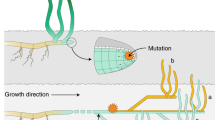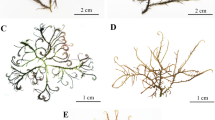Abstract
The phenotypic plasticity often found in seaweed populations has been explained only from the perspective of inter-population or inter-individual differences. However, many seaweeds grow and propagate by fragmentation of genetically identical units, each with the capacity to function on its own. If significant differences in performance exist among these supposedly identical units, such differences should be expressed upon the release and growth of these units. In this study we document two such types of variation in the red seaweed Gracilaria chilensis. Populations of sporelings, each grown under similar culture conditions and derived from carpospores shed by the same cystocarp exhibit significant differences in growth. In this species, each cystocarp develops from a simple gametic fusion, and cystocarp fusions occur too infrequently to account for the growth differences observed among recruits. In adult thalli, branches (ramets) derived from the same thallus (genet) and grown under similar conditions exhibit significant variation in growth rates and morphology. These findings have several implications. They suggest that carpospore production is not only an example of zygote amplification but that it also could increase variability among mitotically replicated units. Intra-clonal variability followed by fragmentation and re-attachment may increase intra-population variation which, in species of Gracilaria, is often larger than inter-population variation. In addition, the existence of intra-clonal variability suggests that strain selection in commercially important species may require a more continuous screening of highquality strains because of frequent genotypic or phenotypic changes in the various cultivars.
Similar content being viewed by others
Literature cited
Bolton, J. J., German, J., Lüning, K., (1983). Hybridizations between Atlantic and Pacific representatives of the Simpleces section of Laminaria (Phaeophyta). Phycologia 22: 133–140
Bonga, J. M., Durzan, D. J. (eds.), (1985). Tissue culture in forestry. Martinus Nijhoff/Dr. Junk Publishers, Dordrecht, Boston, Lancaster
Buss, L. W. (1985). The uniqueness of the individual revisited. In: Jackson, J. B. C., Buss, L. W., Cook, R. C. (eds.) Population biology and evolution of clonal organisms. Yale University Press, New Haven and London, p. 467–505
Carroll, M. A. (1991). Distribution of morphological variation within populations of Gracilaria. J. Phycol. 21 (Suppl.): p. 13
Collantes, G. E., Mello, C. A., Candia, A. J. (1990) Micropropagación clonal, una alternativa biotecnológica en el cultivo de macroalgas marinas chilenas de importancia económica. Archos Biol. Med. exp., Chile 23: 131–140
Cook, R. E. (1985). Growth and development in clonal plant populations. In: Jackson, J. B. C., Buss, L. W., Cook, R. C. (eds.) Population biology and evolution of clonal organisms. Yale University Press, New Haven and London, p. 259–269
Correa, J. A., McLachlan, J. L. (1991). Endophytic algae of Chondrus crispus (Rhodophyta). III. Host specifity. J. Phycol. 27: 448–459
Correa, J. A., Nielsen, R., Grund, D. W. (1988). Endophytic algae of Chondrus crispus (Rhodophyta). II Acrochaete heteroclada sp. nov., A. operculata sp. nov., and Phaeophila dendroides (Chlorophyta). J. Phycol. 24: 528–539
Durako, M. J., Dawes, C. J. (1980). A comparative seasonal study of two populations of Hynea musciformis from the east and west coasts of Florida, USA. I. Growth and chemistry. Mar. Biol. 59: 151–156
Espinoza, J., Chapman, A. R. O. (1983). Ecotypic differentiation of Laminaria longicruris in relation to seawater nitrate concentrations. Mar. Biol. 74: 213–218
Fredericq, S., Hommersand, M. H. (1989). Proposal of the Gracilariales Ord. Nov. (Rhodophyta) based on an analysis of the reproductive development of Gracilaria verrucosa. J. Phycol. 25: 213–227
Gerard, V. A. (1988). Ecotypic differentiation in light-related traits of the kelp Laminaria saccharina. Mar. Biol. 97: 25–36
Guiry, M. D. (1978). The importance of sporangia in the classification of the Florideophyceae. In: Irvine, D. E. G., Price, J. H. (eds.) Modern approaches to the taxonomy of the red and brown algae. Academic Press, London, p. 111–144. (Syst. Ass. Spec. Vol. No. 10)
Hanisak, M. D., Littler, M. M., Littler, D. S. (1988). Significance of macroalgal polymorphism: intraspecific tests of the functional-form model. Mar. Biol. 99: 157–165
Hanisak, M. D., Littler, M. M., Littler, D. S. (1990). Application of the functional-form model to the culture of seaweeds. Hydrobiologia 204/205: 73–77
Hanisak, M. D., Ryther, J. H. (1984). Cultivation biology of Gracilaria tikvahiae in the United States. Hydrobiologia 116/117: 295–298
Harper, J. L. (1985). Modules, branches and the capture of resources. In: Jackson, J. B. C., Buss, L. W., Cook, R. C. (eds.) Population biology and evolution of clonal organisms. Yale University Press. New Haven and London, p. 1–33
Harper, J. L., Rosen, B. R., White, J. (eds.) (1986). The growth and form of modular organisms. Phil. Trans. R. Soc. (Ser. B) 313: 1–250
Hawkes, M. W. (1990). Reproductive strategies. In: Cole, K. M., Sheath, R. G. (eds.), Biology of the red algae. Chapter 17. Cambridge University Press, Cambridge Mass., USA p. 455–476
Hodgson, L. M. (1984). Desiccation tolerance of Gracilaria tikvahiae (Rhodophyta). J. Phycol. 20: 444–446
Hommersand, M. H., Fredericq, S. (1988). An investigation of cystocarp development in Gelidium pteridifolium with a revised description of the Gelidiales (Rhodophyta). Phycologia 27: 254–272
Jackson, J. B. C., Buss, L. W., Cook, R. E. (1985). Clonality: a preface. In: Jackson, J. B. C., Buss, L. W., Cook, R. E. (eds.) Population biology and evolution of clonal organisms. Yale University Press, New Haven and London, p. ix-xi
Lignell, A., Pedersen, M. (1989). Agar composition as function of morphology and growth rate. Studies on some morphological strains of Gracilaria secundata and Gracilaria verrucosa (Rhodophyta). Botanica mar. 32: 219–227
Lüning, K. (1980). Control of algal life-history by day-length and temperature. In: Price, G. H., Irvine, D. E. E., Farnham, W. F. (eds.). The shore environment: methods and ecosystems. Academic Press, London, p. 915–945. (Syst. Ass. Spec. Vol. No. 17)
McLachlan, J. (1973). Growth media, marine. In: Stein, J. R. (ed.) Handbook of phycological methods. Cambridge University Press, Cambridge, Mass., USA, p. 25–51
Müller, D. G. (1991 a). Mendelian segregation of a virus genome during host meiosis in the marine brown alga Ectocarpus siliculosus. J. Pl. Physiol. 137: 739–743
Müller, D. G. (1991 b). Marine virioplankton produced by infected Ectocarpus siliculosus (Phaeophyceae). Mar. Ecol. Prog. Ser. 76: 101–102
Müller, D. G. (1992). Intergeneric transmission of a marine plant DNA virus. Naturwissenschaften 79: 37–39
Müller, D. G., Kawai, H., Stache, B., Lanka, S. (1990). A virus infection in the marine brown alga Ectocarpus siliculosus (Phaeophyceae). Botanica Acta (Ber. dt. bot. Ges.) 103: 72–82
Patwary, M. V., Van der Meer, J. P. (1982). Genetics of Gracilaria tikvahiae (Rhodophyta). VIII. Phenotypic and genetic characterization of some selected morphological mutants. Can. J. Bot. 60: 2556–2564
Patwary, M. V., Van der Meer, J. P. (1983 a). Genetics of Gracilaria tikvahiae (Rhodophyta). IX. Some properties of agars extracted from morphological mutants. Botanica mar. 26: 295–299
Patwary, M. V., Van der Meer, J. P. (1983 b). Growth experiments on morphological mutants of Gracilaria tikvahiae (Rhodophyta). Can. J. Bot. 61: 1654–1659
Patwary, M. V., Van der Meer, J. P. (1983 c) Improvement of Gracilaria tikvahiae (Rhodophyceae) by genetic modification of thallus morphology. Aquaculture, Amsterdam 33: 207–214
Peckol, P., Ramus, J. (1985). Physiological differentiation of North Carolina nearshore and offshore populations of Sargassum filipendula. C. Ag. Botanica mar. 28: 319–325
Prieto, I., Westermeier, R., Müller, D. (1991). Variación de fases reproductivas de Gracilaria chilensis en condiciones de cultivo de terreno y laboratorio. Revta chil. Hist. nat. 64: 343–352
Rice, E. L., Kenchington, T. J., Chapman, A. R. O. (1985). Intraspecific geographic-morphological variation patterns in Fucus dictichus and F. evanescens. Mar. Biol. 88: 207–215
Russell, G. (1986). Variation and natural selection in marine macroalgae. Oceanogr. mar. Biol. A. Rev. 24: 309–377
Santelices, B., Doty, M. S. (1989). A review of Gracilaria farming. Aquaculture, Amsterdam, 78: 95–133
Searles, R. B. (1980). The strategy of the red algal life history. Am. Nat. 115: 113–120
Sheath, R. G., Cole, K. M. (1984). Systematics of Bangia (Rhodophyta) in North America. I. Biogeographic trends in morphology. Phycologia 23: 383–396
Siegel, S., Castellan, N. J. (1988). Nonparametric statistics for the behavioral sciences. McGraw Hill, Inc., New York.
Silander, J. A. (1985). Microevolution in clonal plants. In: Jackson, J. B. C., Buss, L. W., Cook, R. C. (eds.) Population biology and evolution of clonal organisms. Yale University Press, New Haven and London, p. 107–152
Snedecor, G. W., Cochrane, W. G. (1967). Statistical methods. 6th edn. Iowa State University Press, Ames, Iowa
Van der Meer, J. P. (1987). Using genetic markers in phycological research. Hydrobiologia 151/152: 49–56
Van der Meer, J. P., Todd, E. R. (1977). Genetics of Gracilaria sp. (Rhodophyceae, Gigartinales). IV. Mitotic recombinations and its relationship to mixed phases in the life history. Can. J. Bot. 55: 2810–2817
Van der Meer, J. P., Zhang, X. (1988). Similar unstable mutations in three species of Gracilaria (Rhodophyta). J. Phycol. 24: 198–202
Watkinson, H. R., White, J. (1986). Some life-history consequences of modular constructions in plants. Phil. Trans. R. Soc. (Ser. B) 313: 31–51
Author information
Authors and Affiliations
Additional information
Communicated by M. G. Hadfield, Honolulu
Rights and permissions
About this article
Cite this article
Santelices, B., Varela, D. Intra-clonal variation in the red seaweed Gracilaria chilensis . Marine Biology 116, 543–552 (1993). https://doi.org/10.1007/BF00355472
Received:
Accepted:
Issue Date:
DOI: https://doi.org/10.1007/BF00355472




